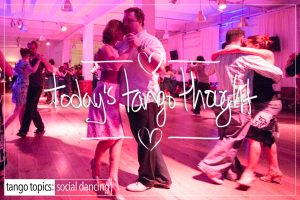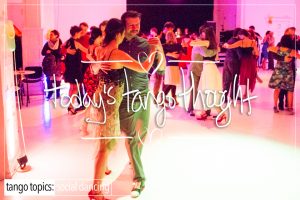There are those of us that separate being ‘good’ as being good enough, and anything beyond that is just ‘unnecessary’. It’s really about getting around the floor, and if no one complains about the embrace, or you don’t hit anything, or anyone, and you can throw in that cool move now and again, so much the better!
What’s the point in working on one’s technique so that it becomes second nature ? Or to continually study and analyze performance videos for hints, attempting to deconstruct what was done in order to glean self improvement ? Or daily solo practice ? Or listening to tango music not just for enjoyment but for familiarity and analysis ? Or taking weekly private lessons ? Or continuing to go to classes at all, or going to practica ? Or most importantly — engaging in self critical or critical self (and others) analysis of the structure of movements, foot placement, arm/hand placement, head position, forearm pressure, hand pressures, shoulder positions, or the detailed analysis of where one places one’s weight over which series of metatarsals and when!
All of that stuff seems…ummm…pointless ? Right ?
Is this perfectionism ? No. It is for one perspective seen as working too hard. Tango is supposed to be easy (ha!), fun. And focus on all that detail is just…a waste of time.
Whatyou may not realize is that ‘work’ and critical self analysis is done in the pursuit of wanting to dance with better and better partners, and more importantly preparing oneself to dance with those better partners. It is an immersion into thinking, breathing, dreaming, eating tango 24/7. And quite honestly that way of being threatens some folks and makes them feel inadequate that they’re not doing enough. And some folks could give a shit, they’re happy with what they are doing. They see nothing wrong with what is going on with their dancing abilities and see no reason to change it.
And that’s the problem right there in a nutshell: the perception that everything is ‘ok’. When in fact it’s not. There’s the hanging, the pulling, the pushing and that’s just the tip of the proverbial iceberg.
Seeing, reading, talking about, anaylysing, criticizing, or engaging in any or all of the above, for some people, takes away the ‘fun’ aspect. Yes those same people may mouth the words of “improvement” but when it comes right down to it…not so much with that. They have commitments, lives, things going on…and tango is just that thing that they go to once a week, sometimes twice, that they have fun with.
And anything or anyone that pokes a hole in their well built justifications for not doing any or all of the above is “perfectionism” or at the very least ‘arrogant presumption’.











